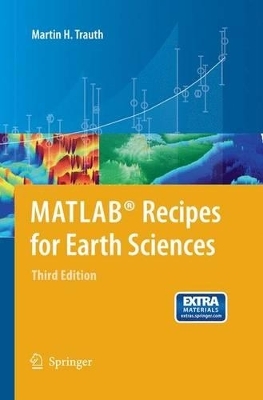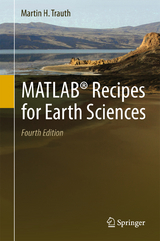MATLAB® Recipes for Earth Sciences
Springer Berlin
978-3-642-12761-8 (ISBN)
- Titel erscheint in neuer Auflage
- Artikel merken
MATLAB. Beyond updating and expanding existing chapters, this Third Edition offers ten new sections. Coverage includes a step by step discussion of each method followed by MATLAB functions.
MATLAB® is used for a wide range of applications in geosciences, such as image processing in remote sensing, the generation and processing of digital elevation models, and the analysis of time series. This book introduces methods of data analysis in geosciences using MATLAB, such as basic statistics for univariate, bivariate and multivariate datasets, jackknife and bootstrap resampling schemes, processing of digital elevation models, gridding and contouring, geostatistics and kriging, processing and georeferencing of satellite images, digitizing from the screen, linear and nonlinear time-series analysis, and the application of linear time-invariant and adaptive filters. The revised and updated Third Edition includes ten new sections and has greatly expanded on most chapters from the previous edition, including a step by step discussion of all methods before demonstrating the methods with MATLAB functions. New sections include: Data Storage and Handling, Data Structures and Classes of Objects, Generating M-Files to Regenerate Graphs, Publishing M-Files, Distribution Fitting, Nonlinear and Weighted Regression, Color-Intensity Transects of Varved Sediments, and Grain Size Analysis from Microscope Images. The text includes numerous examples demonstrating how MATLAB can be used on data sets from earth sciences. All MATLAB recipes can be easily modified in order to analyse the reader's own data sets.
MATLAB® is used for a wide range of applications in geosciences, such as image processing in remote sensing, the generation and processing of digital elevation models, and the analysis of time series. This book introduces methods of data analysis in geosciences using MATLAB, such as basic statistics for univariate, bivariate and multivariate datasets, jackknife and bootstrap resampling schemes, processing of digital elevation models, gridding and contouring, geostatistics and kriging, processing and georeferencing of satellite images, digitizing from the screen, linear and nonlinear time-series analysis, and the application of linear time-invariant and adaptive filters. The revised and updated Third Edition includes ten new sections and has greatly expanded on most chapters from the previous edition, including a step by step discussion of all methods before demonstrating the methods with MATLAB functions. New sections include: Data Storage and Handling, Data Structures and Classes of Objects, Generating M-Files to Regenerate Graphs, Publishing M-Files, Distribution Fitting, Nonlinear and Weighted Regression, Color-Intensity Transects of Varved Sediments, and Grain Size Analysis from Microscope Images. The text includes numerous examples demonstrating how MATLAB can be used on data sets from earth sciences. All MATLAB recipes can be easily modified in order to analyse the reader's own data sets.
Contents Preface 1 Data Analysis in Earth Sciences 1.1 Introduction 1.2 Data Collection 1.3 Types of Data 1.4 Methods of Data Analysis 2 Introduction to MATLAB 2.1 MATLAB in Earth Sciences 2.2 Getting Started 2.3 The Syntax 2.4 Data Storage and Handling 2.5 Data Structures and Classes of Objects 2.6 Scripts and Functions 2.7 Basic Visualization Tools 2.8 Generating M-Files to Regenerate Graphs 2.9 Publishing M-Files 3 Univariate Statistics 3.1 Introduction 3.2 Empirical Distributions 3.3 Example of Empirical Distributions 3.4 Theoretical Distributions 3.5 Example of Theoretical Distributions 3.6 The t-Test 3.7 The F-Test 3.8 The ?2-Test 3.9 Distribution Fitting 4 Bivariate Statistics 4.1 Introduction 4.2 Pearson’s Correlation Coefficient 4.3 Classical Linear Regression Analysis and Prediction 4.4 Analyzing the Residuals 4.5 Bootstrap Estimates of the Regression Coefficients 4.6 Jackknife Estimates of the Regression Coefficients 4.7 Cross Validation 4.8 Reduced Major Axis Regression 4.9 Curvilinear Regression 4.10 Nonlinear and Weighted Regression 5 Time-Series Analysis 5.1 Introduction 5.2 Generating Signals 5.3 Auto-Spectral and Cross-Spectral Analysis 5.4 Examples of Auto-Spectral and Cross-Spectral Analysis 5.5 Interpolating and Analyzing Unevenly-Spaced Data 5.6 Evolutionary Power Spectrum 5.7 Lomb-Scargle Power Spectrum 5.8 Wavelet Power Spectrum 5.9 Nonlinear Time-Series Analysis (by N. Marwan) 6 Signal Processing 6.1 Introduction 6.2 Generating Signals 6.3 Linear Time-Invariant Systems 6.4 Convolution and Filtering 6.5 Comparing Functions for Filtering Data Series 6.6 Recursive and Nonrecursive Filters 6.7 Impulse Response 6.8 Frequency Response 6.9 Filter Design 6.10 Adaptive Filtering 7 Spatial Data 7.1 Types of Spatial Data 7.2 The GSHHS Shoreline Data Set 7.3 The 2-Minute Gridded Global Relief Data ETOPO2 7.4 The 30-Arc Seconds Elevation Model GTOPO30 7.5 The Shuttle Radar Topography Mission SRTM 7.6 Gridding and Contouring Background 7.7 Gridding Example 7.8 Comparison of Methods and Potential Artifacts 7.9 Statistics of Point Distributions 7.10 Analysis of Digital Elevation Models (by R. Gebbers) 7.11 Geostatistics and Kriging (by R. Gebbers) 8 Image Processing 8.1 Introduction 8.2 Data Storage 8.3 Importing, Processing and Exporting Images 8.4 Importing, Processing and Exporting Satellite Images 8.5 Georeferencing Satellite Images 8.6 Digitizing from the Screen 8.7 Color-Intensity Transects of Varved Sediments 8.8 Grain Size Analysis from Microscope Images 8.9 Quantifying Charcoal in Microscope Images 9 Multivariate Statistics 9.1 Introduction 9.2 Principal Component Analysis 9.3 Independent Component Analysis (by N. Marwan) 9.4 Cluster Analysis 10 Statistics on Directional Data 10.1 Introduction 10.2 Graphical Representation 10.3 Empirical Distributions 10.4 Theoretical Distributions 10.5 Test for Randomness of Directional Data 10.6 Test for the Significance of a Mean Direction 10.7 Test for the Difference Between Two Sets of Directions General Index
| Co-Autor | R. Gebbers, N. Marwan |
|---|---|
| Illustrationen | E. Sillmann |
| Sprache | englisch |
| Maße | 160 x 240 mm |
| Gewicht | 660 g |
| Themenwelt | Naturwissenschaften ► Geowissenschaften |
| Schlagworte | Datenanalyse • Digital Elevation Model • directional data • Evolution • geoscience • Geostatistics • Geowissenschaften • Kriging • MATLAB (Software) • Satellite • Sediment • Statistics |
| ISBN-10 | 3-642-12761-4 / 3642127614 |
| ISBN-13 | 978-3-642-12761-8 / 9783642127618 |
| Zustand | Neuware |
| Informationen gemäß Produktsicherheitsverordnung (GPSR) | |
| Haben Sie eine Frage zum Produkt? |


